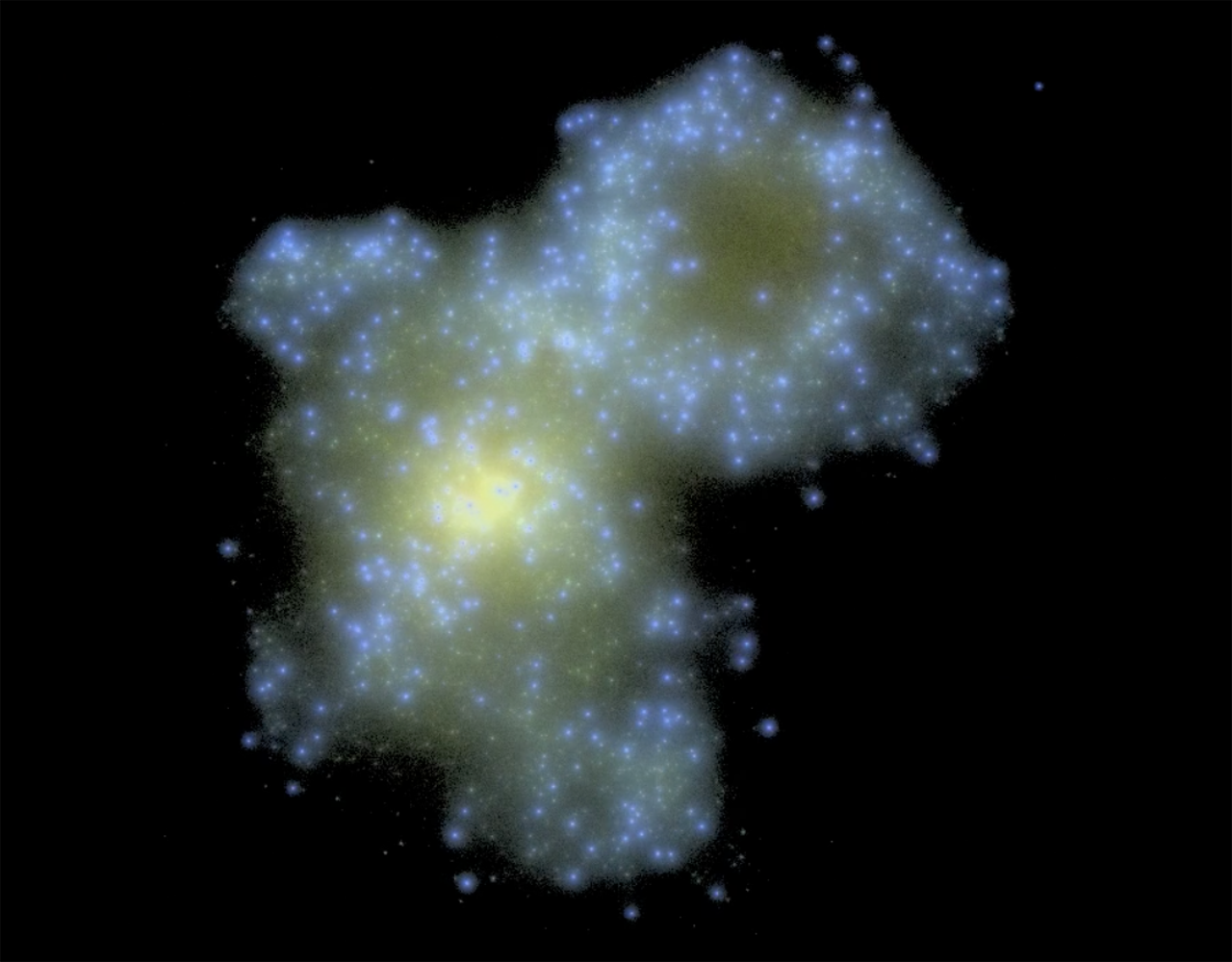This video works with the hologram projector given out at the Galaxy Makers exhibition. You can find a little tutorial on how to use it here.
Congratulations on making a galaxy! You can watch a fly around video of your model galaxy here. If you have a pyramid projector and you are viewing this on your phone then select "hologram video" and play in full-screen mode. You need to make sure your phone is playing the movie horizontally (i.e., hold the phone in front you horizontally before laying it flat). The holograms look best in a dark room with the phone brightness on full (see here for an example of how to use your pyramid). To find out more about your galaxy and how it compares to real galaxies use the buttons below.


Here is an image of your model major merger galaxy and also an image of a real major merger galaxy (the Siamese Twins Galaxies) taken with the Nordic Optical Telescope. You can slide between the two to compare. Major merger galaxies actually means that two (or more) big galaxies are colliding with each other. This type of merger does not directly involve stars colliding (due to the large distances between individual stars) but due gravity, during the collision violent events can occur. For example, major mergers can contain some of the quickest creation of stars in the Universe.
In the real example you can see two spiral galaxies colliding which contain lots of young stars (see the blue/white colours) and lots of gas and dust (see the brown streaks). The model major merger also contains lots of young/blue stars but due to the difficultly of making a perfect model the details are not perfect.
Since a major-merger galaxy is the result of two or more galaxies colliding, there is a large possibility that the galaxy will have two supermassive black holes present, one at the centre of each galaxy. This can result in a double black hole system which is two black holes in close orbit around each other before finally colliding. These black holes contain the same amount of material as millions to billions of stars but all crammed into an incredibly small space. Did you know that our own galaxy the Milky Way will collide with another galaxy called Andromeda in about 4 billion years?
Here is your unique pie chart for your model galaxy that shows you a break down of what your galaxy is made from (by weight). Your galaxy contains lots of young stars (compared to old stars) and lots of gas and dust. However, you can see that the biggest segment represents dark matter. Find out more about these ingredients on the next few pages.

Stars are big balls of very hot gas that produce their own light. Big galaxies contain billions of stars of different sizes and colours. Old stars are usually redder than young stars because stars get colder as they start to run out of fuel. However, some of the heaviest stars end their lives in gigantic explosions called supernovae. Look at the image of your model galaxy and notice where most of the blue (young) stars are found. Collisions between galaxies can often speed up the creation of new stars.

Gas and dust are an important part of galaxies because they are the materials that stars are made from. The violent collisions between the galaxies in your major merger galaxy, which contain lots of gas and dust, helps new stars to be created. This means that in major merger galaxies there is often a lot of hot, young, new stars. In the picture you can see gas around a galaxy, viewed from very far away. This picture was made with a computer and the colours are not real but tell you about the temperature of the gas (hot gas is shown in red). Gas falls onto the galaxy from large distances. This gas will go on to form more stars in the future unless something stops it from getting cold enough to clump together, such as exploding stars or the supermassive black holes.

Did you know that most of the material in the Universe is made of dark matter? Dark matter is the name that we give to matter or "material" that we cannot see and appears to be made up of something other than the regular materials we know about. Astronomers know that this extra dark matter must be present because of the strong effect that its gravity has on light and other objects nearby. This picture shows what the dark matter may look like surrounding a galaxy viewed from a very large distance if you had a special "dark matter" telescope. This model image was made using a computer and the colours are not real; however, bright colours show you where lots of dark matter should be found. Most of the stars in a model galaxy would only found in the central bright region of this picture.

The Astronomy Picture of the Day shows you a new image every day from the world of astronomy, along with an explanation of what it is written by real astronomers.

Space Scoop is a science news website for kids. They cut out all of the confusing jargon and just give you the interesting news from scientists around the world.

Fancy becoming a citizen scientist? Check out Galaxy Zoo, where you can check out cool images of galaxies and help real astronomers by classifying them.

If you would like to find out more information about the simulation and software that produced these images, check out the official EAGLE project website here.